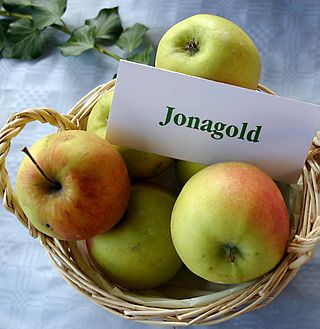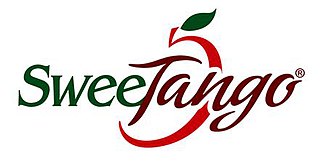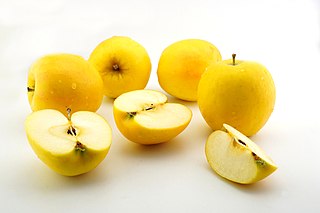
Golden Delicious is a cultivar of apple. It is one of the 15 most popular apple cultivars in the United States. It is not closely related to Red Delicious.

Cider apples are a group of apple cultivars grown for their use in the production of cider. Cider apples are distinguished from "cookers" and "eaters", or dessert apples, by their bitterness or dryness of flavour, qualities which make the fruit unpalatable but can be useful in cidermaking. Some apples are considered to occupy more than one category.

Red Delicious is a type of apple with a red exterior and sweet taste that was first recognized in Madison County, Iowa, in 1872. Today, the name Red Delicious comprises more than 50 cultivars. It was the most produced cultivar in the United States from 1968 to 2018, when it was surpassed by Gala.

Jonagold is a cultivar of apple that is a cross between the crisp Golden Delicious and the blush-crimson Jonathan; the name Jonagold is a portmanteau of these two variety names. It was developed in 1943 in New York State Agricultural Experiment Station of Cornell University's College of Agriculture and Life Sciences, selected as N.Y. 43013-1 in 1953, officially released in 1968 by Roger Way.

Honeycrisp is an apple cultivar developed at the Minnesota Agricultural Experiment Station's Horticultural Research Center at the University of Minnesota, Twin Cities. Designated in 1974 with the MN 1711 test designation, patented in 1988, and released in 1991, the Honeycrisp, once slated to be discarded, has rapidly become a prized commercial commodity, as its sweetness, firmness, and tartness make it an ideal apple for eating raw. "...The apple wasn't bred to grow, store or ship well. It was bred for taste: crisp, with balanced sweetness and acidity." It has larger cells than most apple cultivars, a trait which is correlated with juiciness, as larger cells are more prone to rupturing instead of cleaving along the cell walls; this rupturing effect is likely what makes the apple taste juicier. The Honeycrisp also retains its pigment well and has a relatively long shelf life when stored in cool, dry conditions. Pepin Heights Orchards delivered the first Honeycrisp apples to grocery stores in 1997. The name Honeycrisp was trademarked by the University of Minnesota, but university officials were unsure of its protection status in 2007. It is now the official state fruit of Minnesota. A large-sized honeycrisp will contain about 113 calories.

Cripps Pink is a cultivar of apple. It is one of several cultivars sold under the trade mark name Pink Lady. It was originally bred by John Cripps at the Western Australia Department of Agriculture, by crossing the Australian apple Lady Williams with a Golden Delicious; the result is a combination of the firm, long-storing property of Lady Williams with the sweetness and lack of storage scald of Golden Delicious.

'Ambrosia' is a cultivar of apple originating in British Columbia, Canada in the early 1990s. The original tree was first cultivated by the Mennell family of Similkameen Valley, British Columbia, who discovered it growing in their orchard.

An apple is a round, edible fruit produced by an apple tree. Apple trees are cultivated worldwide and are the most widely grown species in the genus Malus. The tree originated in Central Asia, where its wild ancestor, Malus sieversii, is still found. Apples have been grown for thousands of years in Eurasia and were introduced to North America by European colonists. Apples have religious and mythological significance in many cultures, including Norse, Greek, and European Christian tradition.

The Zestar! apple or Minnewashta (cultivar) is an apple cultivar released in 1999. It was developed by the horticulturalists at the Minnesota Landscape Arboretum's Horticultural Resource Center, at the University of Minnesota.

The 'York Imperial', or 'York', is a cultivar of apple from which a number of other valuable strains and cultivars have arisen, including four sport varieties: Commander York, Ramey York, Red Yorking, and Yorking.

The Foxwhelp is a very old cider apple cultivar, originating in the west Midlands of England.

SweeTango is the brand name of the cultivated apple 'Minneiska'. It is a cross between the 'Honeycrisp' and the Zestar Apple belonging to the University of Minnesota. The apple is controlled and regulated for marketing, allowing only exclusive territories for growing. It has a sweet-tart taste that some food writers have described as something between brown sugar and spiced apple cider.

The Wealthy is an American apple cultivar, and was the earliest to thrive in the Minnesota climate. Horticulturalist Peter Gideon grew it after years of trial and error with various apple varieties, and the fruit was described in 1869.
Arctic apple is the trademark for a group of patented apples that contain a nonbrowning trait introduced through biotechnology. They were developed through a process of genetic engineering by Okanagan Specialty Fruits Inc. Specifically, gene silencing reduces the expression of polyphenol oxidase (PPO), thus delaying the onset of browning. It is the first genetically engineered apple to be approved for commercial sale. The US Food and Drug Administration (FDA) in 2015, and the Canadian Food Inspection Agency, Government of Canada in 2017, determined that Arctic apples are as safe and nutritious as conventional apples.

opal® is the brand name for apple cultivar 'UEB 32642'. The variety originates from a natural crossing of 'Golden Delicious' with 'Topaz'.

The Lodi is an apple cultivar that is a hybrid of the 'Yellow Transparent' and 'Montgomery Sweet' cultivars, both of which were originally from the New York Agricultural Experiment Station. It was introduced in 1924 and is commonly grown in the Southern United States.
'Autumn Bough' is an early ripening cultivar of domesticated apple also known by various other names including 'Montgomery Sweet', 'Philadelphia Sweet', 'Sweet Bellflower', 'Sweet Harvest', and 'White Sugar'.

Cosmic Crisp is an American apple with the variety designation 'WA 38'. Breeding began in 1997 at the Washington State University (WSU) Tree Fruit Research and Extension Center in Wenatchee, Washington, and was initially overseen by Bruce Barritt. Kate Evans completed the research after Barritt's retirement from WSU.

The MN55 cultivar apple developed by David Bedford, a senior researcher and research pomologist at the University of Minnesota's apple-breeding program, and James Luby, PhD, professor, Department of Horticultural Sciences, Horticultural Research Center, is a cross between Honeycrisp and MonArk (AA44), a non-patented apple variety grown in Arkansas.
EverCrisp is an American apple cultivar developed by the Midwest Apple Improvement Association (MAIA). Trademarked as EverCrisp, the MAIA-1 variety is a cross between two existing apple cultivars: the Honeycrisp and Fuji. Originally produced in Ohio, EverCrisp has since expanded to apple-growing regions across the Midwest in Michigan, Illinois and Indiana, in the Northeast in Pennsylvania and New York, and in the Northwest in Washington. The apple entered the public marketplace in 2017.
















